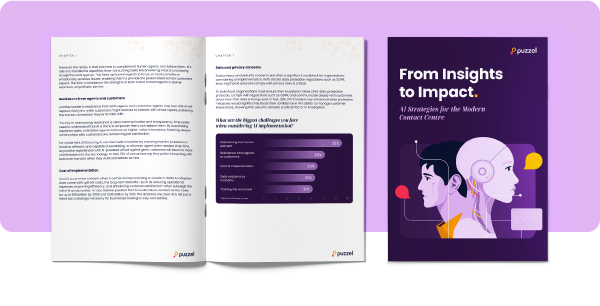The case for cloud in the contact centre
It’s an ongoing discussion for CX organisations: to cloud or not to cloud? As customer expectations rise and businesses adapt to new ways of working, the shift to cloud-based solutions is becoming increasingly important. In fact, 79% of CX leaders agree that the right cloud technologies are essential for optimising their contact centres, according to Forrester. Despite this, many organisations still hesitate to make the switch — often questioning whether the benefits of cloud migration truly outweigh the investment. If you’re one of them, you’re not alone. Moving away from long-standing on-premises systems can feel like a daunting leap, especially when there’s uncertainty around costs, disruptions, and ROI. But what happens if you don’t modernise? And what exactly are the benefits of moving to a cloud-based contact centre?
Chapter 1
These hidden costs not only drain internal resources but also limit your ability to deliver seamless, connected customer experiences.
Related content: Outdated contact centre tech: 5 red flags to watch for
The hidden costs of legacy systems
On-premises contact centre solutions might feel like the safer option — familiar, reliable, and seemingly under control. However, beneath the surface, they often come with hidden costs that impact both operational efficiency and customer experience. Here’s what legacy systems are really costing organisations on on-premises:
• Maintenance overhead: On-premises systems require dedicated IT teams to handle updates, troubleshooting, security patches, and hardware maintenance. Beyond the costs associated with hardware upkeep and software upgrades, IT teams also face the challenge of managing servers, data storage, and security protocols—all of which demand time and resources that could be better spent on strategic initiatives.
• Limited innovation: Many legacy systems struggle to keep up with modern customer demands, particularly when it comes to integrating new technologies like AI. Plus, with on-premises infrastructure, IT teams often find themselves focused on maintaining outdated systems rather than driving new initiatives.
• Siloed data and inefficient workflows: Many on-premises solutions lack seamless integration with modern business applications, leading to fragmented data across different platforms. This makes it harder for agents to access a complete view of customer interactions, slowing down resolution times and reducing the ability to deliver a seamless, personalised experience.
• IT complexity: Technology should make work easier, not harder. Yet for many contact centres still relying on legacy systems, IT complexity is a daily challenge. Disjointed systems require frequent updates and manual fixes, rigid infrastructure makes it difficult to adapt to changing business needs, and long deployment times slow down innovation.
Four reasons to make the switch to cloud-based technology
Migrating to the cloud offers far more than just a technological upgrade. For contact centres, embracing cloud-based solutions brings a wide range of advantages that positively impact both operations and customer experience. Here’s why making the move is a smart decision:
Cost savings: One of the most compelling reasons to transition to the cloud is the potential for substantial cost savings. Unlike on-premises systems that often require heavy upfront investments in hardware, ongoing maintenance, and in-house IT support, cloud solutions operate on a subscription-based model. This eliminates many of the hidden costs of traditional systems and offers more predictable expenses that can be easily budgeted for over time.
Example: A Total Economic Impact™ (TEI) study found that a composite organisation saved €2.4 million over three years by switching from on-premises to Puzzel’s cloud solution, significantly reducing technology costs year after year.
Supporting remote working: Cloud solutions are designed for flexibility, making them the ideal choice for remote and hybrid contact centres. Agents can securely access systems and customer data from anywhere, ensuring business continuity and enabling organisations to hire top talent without geographical restrictions.
According to Science of People, 59% of workers are more likely to choose an employer that allows remote work, making the cloud an essential solution for contact centres looking to support flexible working arrangements.
Reduced IT complexity: Cloud platforms simplify IT management by removing the need for on-site physical servers. With cloud solutions, maintenance, updates, and security are handled automatically, freeing up IT teams to focus on more strategic initiatives.
Cloud platforms also offer enhanced security, with 24/7 monitoring, automatic updates, and built-in redundancy to minimise risks like cyber threats or hardware failures. Many cloud providers offer enterprise-grade security protections that exceed what most in-house IT teams can provide, reducing downtime and ensuring compliance with industry regulations.
Faster deployment of new features: Adapting to changing customer expectations requires agility, and cloud-based contact centres are built for just that. Whether integrating CRM systems, AI-powered solutions, or workforce management tools, cloud platforms enable seamless updates without disruptive, time-consuming installations.
Cloud solutions also allow contact centres to scale operations up or down instantly, whether to support seasonal demand, add new customer service channels, or onboard remote agents. This flexibility ensures businesses can respond quickly to market changes—without the delays and costs associated with legacy systems.
https://www.puzzel.com/resources/forrester-tei-study
https://www.demandsage.com/remote-work-statistics/
Overcoming the fear of switching
Making the move to the cloud involves a significant change. Questions about data security, potential downtime, and maintaining control often come up when organisations consider making the switch. With the right approach, these fears can be addressed—making cloud migration a smooth and strategic move for your contact centre. Let’s break down some of the most common concerns and how a well-planned cloud transition can help overcome them.
Chapter 2: Data security and privacy
One of the top concerns for any organisation moving to the cloud is security. With cyber threats on the rise, contact centres handling sensitive customer data need reassurance that their information is protected.
Solution: Choose a trusted provider that meets your security and compliance needs. Reputable vendors offer end-to-end encryption, multi-layered security protocols, and strict access controls to protect customer data. Look for vendors that comply with international security standards like GDPR, ISO 27001, and PCI DSS, ensuring data protection at every stage—from migration to day-to-day operations.
Downtime during migration
Another common fear is the potential for downtime or disruption during the migration process. Contact centres worry about the impact of downtime on customer support, agent productivity, and overall operations.
Solution: A phased migration approach ensures critical operations remain running while teams transition gradually. This allows your contact centre to adopt new features step by step without overwhelming agents or customers. Many cloud providers offer dedicated support teams who guide organisations through migration, ensuring a seamless transition with minimal impact on service levels.
Loss of control over IT infrastructure
For organisations accustomed to having complete control over their on-premises systems, the idea of entrusting data and processes to a third-party cloud provider can feel like a loss of control.
Solution: The cloud doesn’t mean giving up control—it simply changes how control is managed. Cloud platforms offer powerful tools like customisable dashboards, detailed reporting, and role-based access controls. This gives your team more insight into operations and allows you to manage performance with precision.
Additionally, most cloud providers offer service-level agreements (SLAs) that guarantee uptime and system performance, giving you the peace of mind that your system will run smoothly and reliably.
Integration with existing systems
Many contact centres rely on a variety of systems—from CRMs and workforce management tools to reporting and analytics solutions. The thought of migrating to the cloud and having to integrate everything seamlessly can feel overwhelming.
Solution: Cloud platforms are designed with integration in mind. They offer open APIs and pre-built connectors that integrate with popular CRMs and business tools, reducing the complexity of the migration process. Conducting an audit of current systems and working with your vendor to plan integrations before the migration can further ease the transition, ensuring all systems function harmoniously from day one.
Practical tips for managing migration
Transitioning to the cloud doesn’t have to be daunting. With careful planning and a few key strategies, contact centres can manage migration smoothly and confidently. Here’s a step-by-step guide to help you navigate your cloud migration and make the most of your investment.
Chapter 3: Assessing your current infrastructure
The first step in any migration is understanding your existing setup. A thorough audit of your contact centre’s systems, processes, and technologies will help identify inefficiencies, outdated tools, and areas for improvement. This ensures you prioritise the right components for migration and determine what may need upgrading or replacing. Consider the following key questions during your assessment:
• What systems are integral to your current operations, and how will they integrate with the cloud?
• Are there any legacy systems that need to be phased out before migration?
• Which areas are most critical for your contact centre’s day-to-day operations, and how can they benefit from cloud technology?
• A comprehensive assessment will ensure that your migration is as efficient as possible and that no critical components are overlooked.
A detailed assessment lays the foundation for an efficient migration, reducing the risk of disruption and ensuring all critical components are accounted for.
Building a business case for cloud migration
Choosing the right cloud provider
Once you have a clear picture of your current infrastructure, securing buy-in from leadership and stakeholders is the next step. A strong business case should highlight the tangible benefits of cloud migration and align with your organisation’s strategic goals.
Key points to include:
• Cost savings: Cloud platforms operate on a subscription model, reducing hardware and maintenance costs while offering predictable pricing.
• Scalability and flexibility: Easily scale operations up or down without major infrastructure changes, adapting to business needs in real time.
• Improved customer experience: Enable faster response times, more personalised interactions, and better data access for agents.
• Security and compliance: Ensure your chosen provider meets industry standards like GDPR, ISO 27001, or PCI DSS, offering robust data protection.
Selecting the right cloud provider is crucial to a successful migration. The ideal vendor should not only offer the features you need but also provide strong security, scalability, and ongoing support.
Factors to consider:
• Reputation and reliability: Look for a provider with a proven track record in the contact centre industry, ensuring high uptime and secure data practices.
• Customisation and integration: Ensure the platform integrates seamlessly with your existing tools, such as CRM, workforce management, and AI solutions.
• Security measures: Prioritise providers with strong encryption, multi-factor authentication, and regular security audits to safeguard sensitive data.
• Support and training: A vendor should offer comprehensive support during and after migration, including training resources for agents and IT teams.
Choosing the right provider will make the transition smoother and ensure long-term success.
Manage change and train your team
The success of your cloud migration hinges not just on the technology but also on how well your team adapts to the changes. Change management is key to ensuring a smooth transition and maximising the value of your new system. Here’s how to prepare your team for the shift:
• Engage your team early: Communicate the benefits of migration to agents, IT staff, and leadership to minimise resistance.
• Invest in training: Provide tailored, ongoing training for all users to ensure they’re confident with the new system.
• Adopt a phased rollout: Start with a pilot programme or a smaller department before full implementation, allowing time to address any issues.
• Monitor and adjust: Continuously track system performance and gather feedback from users to refine processes and optimise workflows.
With the right preparation and support, your team will be ready to embrace the new technology, making your cloud transformation a success.
Bonus tip: Use Puzzel’s ROI calculator to learn how much you could potentially save by moving your contact centre from an on-premises setup to a cloud platform.
The ROI of moving from on-premises to the cloud with Puzzel.
Key benefits:
Forrester Consulting conducted a Total Economic Impact™ (TEI) study to explore the potential cost savings and ROI of deploying Puzzel’s cloud-based CX platform. The study found that the composite organisation significantly reduced technology costs by moving from on-premises to Puzzel’s cloud-based solution. Over three years, the composite organisation realised €2.4 million in savings by reducing technology-related expenses. Ultimately, the TEI study provided clear evidence of the value Puzzel delivers to organisations. The representative interviews and financial analysis found that Puzzel brings meaningful value to organisations, with the composite organisation experiencing benefits of €12,98M over three years versus costs of €3,43M. This resulted in a net present value (NPV) of €9,55M and an impressive ROI of 278%.
278% €9,55M €12,98M 6 months
ROI NPV benefits payback
Voice of the customer:
“Puzzel is an intuitive, out-of-the-box, cloud-based, and easily scalable solution. We can work from anywhere and take calls from anywhere, which was good [during unexpected circumstances], such as during the COVID-19 pandemic.”
CUSTOMER SERVICE DIRECTOR, RETAIL COMPANY
“For us, it was also very much about consolidation of platforms: three on-prem and this one. … Pulling those into one platform was a significant saving. ... It has been around €5 million per year.”
NORDIC DEVELOPMENT LEAD, INSURANCE COMPANY.
Achieving long-term success with a cloud-first contact centre.
Moving to the cloud is just the beginning. To truly unlock the potential of a cloud-first contact centre, organisations need to stay focused on setting clear goals, measuring outcomes, and constantly refining their systems and processes. In this chapter, we’ll explore the key steps to ensure long-term success, from defining the right KPIs to nurturing a customer-centric culture.
Continuous optimisation and upgrades
The cloud thrives on continuous evolution. Adopting a proactive approach to technology upgrades and CX strategy improvements is key to staying ahead in a competitive environment. Cloud platforms regularly roll out new features and updates, from advanced AI tools to integration capabilities. By making the most of these upgrades, you not only improve operational efficiency but also create a more seamless customer journey.
Empowering agents through training
Your agents are at the heart of the customer experience, so keeping them informed and equipped with the latest tools is crucial. Continuous training ensures they’re empowered to make the most of new technology, which ultimately helps them deliver exceptional support, every time.
Evolving with your customers
Modern consumers are constantly changing, embracing new communication channels and expecting increasingly personalised interactions. By closely monitoring customer behaviour and feedback, your team can identify emerging trends and adapt service strategies accordingly. For instance, if mobile app usage or self-service options are on the rise, your cloud platform can integrate these channels, allowing you to meet customers where they are, with minimal friction.
Taking advantage of AI
AI is no longer just a futuristic concept- it’s here and it’s already driving business benefits. For contact centres, embracing AI means optimising workflows, enhancing operational efficiency, and empowering agents to deliver more value. AI-powered automation can significantly reduce operational costs while improving efficiency. In fact, McKinsey estimates that AI could automate up to 50% of routine customer interactions, resulting in substantial cost savings.
Chapter 4
Positively, one of the key benefits of cloud solutions is how they simplify the integration of AI tools. Today’s cloud platforms seamlessly incorporate AI-powered features like chatbots, AI agents, and intelligent routing systems. These tools help to automate routine tasks, personalise customer interactions, and provide valuable insights, all of which contribute to a more efficient, customer-centric, and employee-friendly contact centre.
The role of AI and automation in cloud-based contact centres
Here’s how AI and automation are transforming cloud contact centres:
Chatbots and Virtual Agents
AI-powered chatbots and virtual agents can manage a wide range of customer queries, from answering frequently asked questions to processing simple transactions. This reduces the burden on agents while ensuring customers get immediate responses, even outside of business hours.
AI-powered virtual agents are transforming self-service by providing intelligent, conversational support across multiple channels, including:
• Chatbots for web and messaging apps: AI agents can handle routine inquiries, process transactions, and provide troubleshooting guidance through chat interfaces.
• AI voice assistants for phone support: Instead of navigating complex IVR menus, customers can interact naturally with AI-powered voice bots that understand intent and provide real-time assistance.
• Automated email handling: AI can categorise, prioritise, and even draft responses to customer emails, significantly reducing manual effort.
By taking care of repetitive requests, virtual agents free up CX teams to focus on complex cases that require human judgement. When a chatbot reaches its limit, it can transfer the conversation to a live agent along with the full interaction history, so customers don’t have to repeat themselves.
“Our relationship with Puzzel has allowed us to continuously adapt and grow, ensuring we’re always one step ahead in delivering exceptional service”
Conversational intelligence: Understanding customers on a deeper level
Conversational intelligence takes AI capabilities beyond simple automation by analysing customer interactions in real time to extract insights, detect sentiment, and improve responses.
AI-powered conversational intelligence can:
• Analyse tone and sentiment: Detect frustration, urgency, or satisfaction in a customer’s voice or text messages, helping agents adjust their approach in the moment.
• Identify trends and insights: Spot recurring issues or customer concerns that may need to be addressed at a business level.
• Provide real-time coaching: Offer on-screen prompts or suggested responses to help agents handle conversations more effectively.
By integrating conversational intelligence into cloud-based contact centres, businesses can enhance customer interactions, provide proactive support, and improve overall service quality.
AI-powered assistants: Smarter, faster decision-making
Instead of manually searching for information, agents can rely on AI-powered tools that provide real-time suggestions. These tools pull insights from knowledge bases, past interactions, and CRM data to offer relevant responses, recommended next steps, and automated summaries of previous conversations. This reduces cognitive load on agents, speeds up resolutions, and ensures a more consistent customer experience.
Workforce automation: Smarter scheduling and forecasting
AI also plays a critical role in workforce optimisation by predicting call volumes, automating shift scheduling, and ensuring the right number of agents are available at any given time. This helps businesses:
• Improve staffing accuracy and reduce costs
• Prevent agent burnout by balancing workloads more effectively
• Adapt to demand fluctuations in real time
With AI-driven workforce management, contact centres can maintain service levels while keeping operations efficient and agile.
How cloud technology empowers agents
Behind every great customer experience is a great agent. Moving to a cloud-based contact centre empowers agents with the tools they need to work smarter, collaborate more easily, and ultimately deliver better service.
Access from anywhere, anytime
Cloud-based systems break down the barriers of traditional contact centre setups. Agents no longer need to be tied to a physical desk or office. Whether they’re working from home, in the office, or on the go, they can access everything they need to handle customer queries seamlessly. This flexibility not only boosts agent morale but also enables better work-life balance, leading to higher job satisfaction.
Unified interfaces for simpler workflows
Many contact centre agents still juggle multiple platforms to manage customer interactions—switching between phone systems, email clients, chat tools, and CRM systems. This fragmented approach not only slows agents down but also creates frustration and increases the risk of errors.
Cloud-based contact centres offer unified interfaces that bring everything together in one place. With all communication channels, customer data, and task management tools accessible from a single dashboard, agents can:
• Respond to customers faster.
• Focus on conversations instead of navigating different systems.
• Easily switch between voice, chat, email, and social channels without losing context.
This streamlined way of working helps agents become more efficient and confident in their roles.
Chapter 5: Breaking down silos for better collaboration
Cloud solutions offer collaboration features that enable agents to connect with teammates and supervisors in real-time. Whether it’s escalating a case, asking for help, or collaborating on a strategy, agents can quickly share information and find solutions together. This seamless collaboration reduces downtime, resolves issues faster, and ensures agents never feel isolated.
Better access to customer data
One of the biggest frustrations for agents is not having the right information at the right time. Cloud contact centres integrate directly with CRMs and other business systems, giving agents instant access to customer data during every interaction. With customer history, previous interactions, and purchase details readily available, agents can:
• Personalise conversations.
• Resolve queries faster.
• Avoid asking customers to repeat information.
This not only improves efficiency but also creates a more seamless and satisfying experience for customers.
Agent happiness = better customer experience
There’s a clear connection between agent happiness and customer satisfaction. When agents feel supported and empowered, they perform better—and customers notice.
According to Puzzel’s Total Economic Impact™ (TEI) study conducted by Forrester, organisations using Puzzel saw agent productivity gains worth €10.3 million over three years.
These gains were driven by:
• Improved visibility into customer interactions.
• Increased automation of manual tasks.
• Streamlined operations that made daily work easier.
The study also found that dynamic channel blending allowed agents to become multi-skilled, taking on up to 20% more tasks without compromising service quality.
Related content: A practical guide to contact centre agent happiness.
https://www.puzzel.com/resources/forrester-tei-study-2024
https://www.puzzel.com/resources/a-practical-guide-to-contact-centre-agent-happiness
Conclusion
Moving to the cloud is a significant step for any contact centre, bringing greater flexibility, efficiency, and scalability. With cloud technology, contact centres can adapt to customer needs more easily, streamline operations, and provide agents with the tools they need to succeed. From simplifying workflows to supporting remote and hybrid teams, the cloud removes many of the barriers that come with traditional on-premises systems. It also opens the door to AI-driven automation, seamless integrations, and real-time insights that help teams work smarter.
A successful cloud transformation starts with the right approach—careful planning, clear communication, and a platform that aligns with your business goals. While change can be challenging, the benefits far outweigh the effort, leading to a more agile and future-ready contact centre. Wherever you are in your cloud journey, the key is to focus on what works best for your organisation and your customers. With the right strategy, your contact centre can continue evolving and stay ahead of the competition - delivering the best possible experience."




